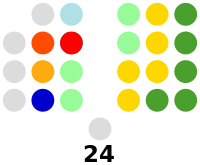Our website is made possible by displaying online advertisements to our visitors.
Please consider supporting us by disabling your ad blocker.
Senate of the Philippines
Senate of the Philippines Senado ng Pilipinas | |
|---|---|
| 19th Congress of the Philippines | |
 | |
 Flag of the Senate of the Philippines | |
| Type | |
| Type | |
Term limits | 2 consecutive terms (12 years) |
| History | |
| Founded | October 16, 1916 |
| Preceded by | Second Philippine Commission |
| Leadership | |
| Structure | |
| Seats | 24 senators |
 | |
Political groups | Majority bloc (15)
Minority bloc (2)
Independent bloc (6)
Vacant (1)
|
| Committees | 41 standing committees |
Length of term | 6 years, renewable once |
| Authority | Article VI, Constitution of the Philippines |
| Elections | |
| Plurality-at-large voting | |
Last election | May 9, 2022 (12 seats) |
Next election | May 12, 2025 (12 seats) |
| Meeting place | |
 | |
| GSIS Building, Financial Center, Jose W. Diokno Boulevard, Pasay | |
| Website | |
| senate | |
| Rules | |
| Rules of the Senate (English) | |
 |
|---|
|
|
The Senate of the Philippines (Filipino: Senado ng Pilipinas) is the upper house of Congress, the bicameral legislature of the Philippines, with the House of Representatives as the lower house. The Senate is composed of 24 senators who are elected at-large (the country forms one district in senatorial elections) under a plurality-at-large voting system.
Senators serve six-year terms with a maximum of two consecutive terms, with half of the senators elected in staggered elections every three years. When the Senate was restored by the 1987 Constitution, the 24 senators who were elected in 1987 served until 1992. In 1992, the 12 candidates for the Senate obtaining the highest number of votes served until 1998, while the next 12 served until 1995. Thereafter, each senator elected serves the full six years. From 1945 to 1972, the Senate was a continuing body, with only eight seats up every two years.
Aside from having its concurrence on every bill in order to be passed for the president's signature to become a law, the Senate is the only body that can concur with treaties and try impeachment cases. The president of the Senate is the presiding officer and highest-ranking official of the Senate. They are elected by the entire body to be their leader and are second in the Philippine presidential line of succession. The current officeholder is Francis Escudero.
Previous Page Next Page


